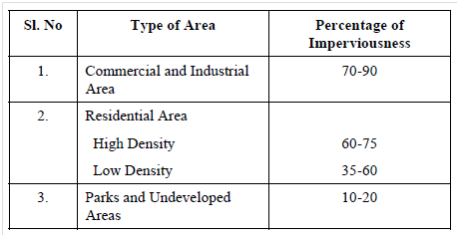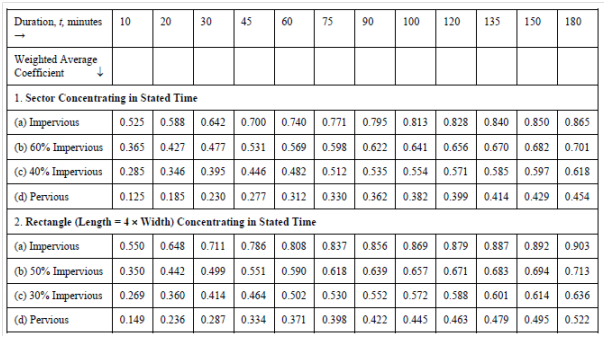Estimation Of Storm Runoff
Storm runoff is that portion of the precipitation, which drains over the ground surface. The design of stormwater sewers begins with an estimate of the rate and volume of surface runoff. When rain falls on a given catchments, a part of the precipitation is intercepted by the vegetation cover which mostly evaporates, some part hits the soil and some of it percolates down below and the rest flows on ground surface. Estimation of such runoff reaching the storm sewers is dependent on intensity and duration of precipitation, characteristics of the tributary area and time required for such flow to reach the sewer. More the intensity of rain, the higher will be the peak runoff rate.
The features of the drainage area such as imperviousness, topography including depressions and water pockets, shape of the drainage basin and duration of the precipitation determine the fraction of the total precipitation, which will reach the sewer. This fraction is known as the coefficient of runoff.
The time period, after which the entire area begins contributing to the total runoff, at a given monitoring point, is known as the time of concentration, vis-a-vis, that point - it is also obviously defined as the time it takes a drop of water to flow from hydraulically most distant point of the basin to the outlet of the basin. The duration of rainfall that is equal to the time of concentration is known as the critical rainfall duration. The rational formula expresses the relationship between peak runoff, and rainfall, as follows:
Q = 10 . C . i . A
where Q = Runoff in m3/hr,
C = A dimensionless runoff coefficient,
i = Intensity of rainfall in mm/hr, and
A = Area of drainage district in hectares.
It may be reiterated that Q represents only the maximum discharge caused by a particular storm.
The portion of rainfall, which finds its way to the sewer, is dependent on the imperviousness and the shape of the drainage area apart from the duration of storm. The percent imperviousness of the drainage area can be obtained from the records of a particular district. In the absence of such data, Table 4 below may serve as a guide.
Table 4 : Percentage of Imperviousness for Various Areas (CPHEEO, 1993)

When several different surface types or land use which comprise the drainage area, a composite or weighted average value of the imperviousness runoff coefficient can be computed, such as:
I = 1/A ×(A1 × I1 + A2 × I2 + A3 × I3+ . . . + An In )
where the subscripts refer to respective sub-drainage area types, and A obviously is the total drainage area.
The weighted average runoff coefficients for rectangular areas of length four times the width as well as for sector shaped areas with varying percentages of impervious surface for different time of concentration are given in Table 5. Although these are applicable to particular shape areas, they also apply in a general way to the areas, that are commonly encountered in practice. Errors due to difference in shape of drainage are within the limits of accuracy of the rational method and of the assumptions on which it is based.
Table 6.5: Runoff Coefficients (CPHEEO, 1993)
